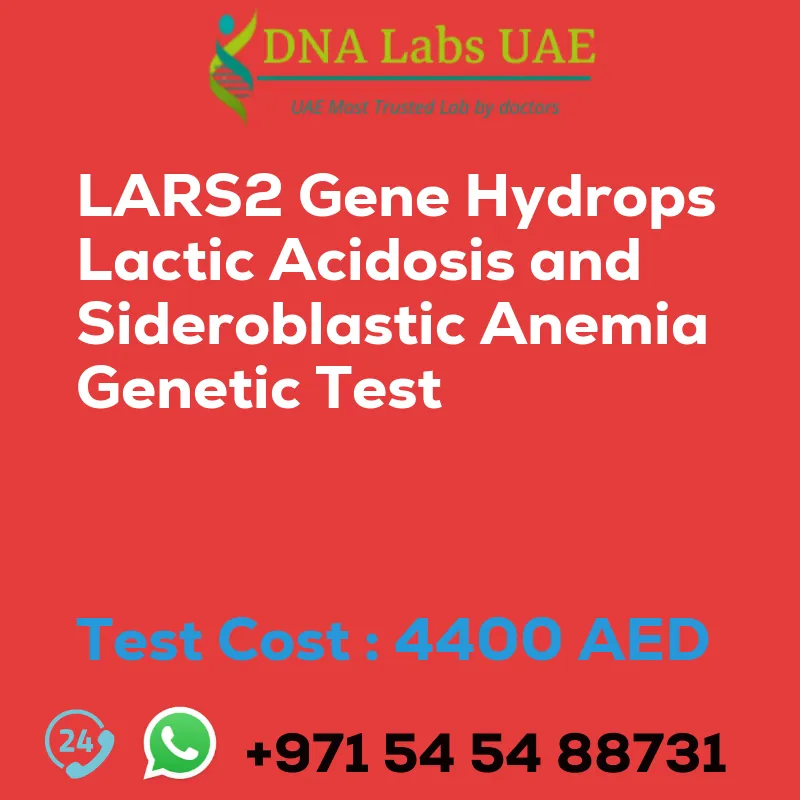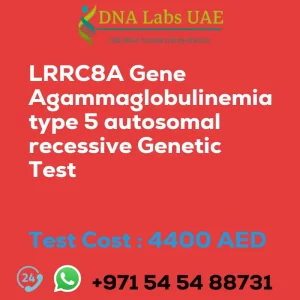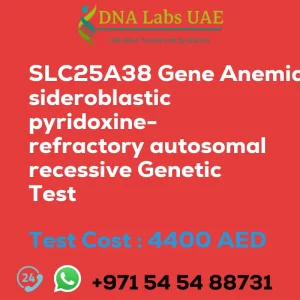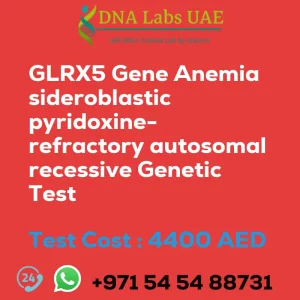LARS2 Gene Hydrops lactic acidosis and sideroblastic anemia Genetic Test
Cost: AED 4400.0
Test Name: LARS2 Gene Hydrops lactic acidosis and sideroblastic anemia Genetic Test
Components: Blood or Extracted DNA or One drop Blood on FTA Card
Report Delivery: 3 to 4 Weeks
Method: NGS Technology
Test type: Hematology
Doctor: Hematologist
Test Department: Genetics
Pre Test Information: Clinical History of Patient who is going for LARS2 Gene Hydrops, lactic acidosis, and sideroblastic anemia NGS Genetic DNA Test. A Genetic Counselling session to draw a pedigree chart of family members affected with LARS2 Gene Hydrops, lactic acidosis, and sideroblastic anemia NGS Genetic DNA Test gene LARS2
Test Details
The LARS2 gene is responsible for providing instructions for making an enzyme called leucyl-tRNA synthetase. This enzyme plays a crucial role in protein synthesis, specifically in attaching the amino acid leucine to its corresponding transfer RNA (tRNA) molecule during protein production.
Mutations in the LARS2 gene can lead to a rare genetic disorder known as hydrops, lactic acidosis, and sideroblastic anemia (HLASA). This condition is inherited in an autosomal recessive manner, meaning that an individual must inherit two copies of the mutated gene (one from each parent) to develop the disorder.
Hydrops refers to the accumulation of fluid in different body cavities, such as the abdomen, chest, or under the skin. Lactic acidosis is a condition characterized by the buildup of lactic acid in the blood, leading to symptoms like muscle weakness, fatigue, and rapid breathing. Sideroblastic anemia is a type of anemia where the body has difficulty producing healthy red blood cells, resulting in a reduced ability to carry oxygen.
To diagnose HLASA, a next-generation sequencing (NGS) genetic test can be performed. NGS allows for the simultaneous analysis of multiple genes, including the LARS2 gene, to identify any disease-causing mutations. This type of testing is highly accurate and can provide a definitive diagnosis for individuals suspected of having HLASA.
Once diagnosed, management of HLASA typically involves supportive care to address the specific symptoms and complications associated with the disorder. This may include treatments such as blood transfusions, iron chelation therapy to reduce iron overload, and addressing any underlying metabolic abnormalities.
It is important to consult with a healthcare professional or a genetic counselor for further information and guidance regarding HLASA and the specific genetic testing options available.
| Test Name | LARS2 Gene Hydrops lactic acidosis and sideroblastic anemia Genetic Test |
|---|---|
| Components | |
| Price | 4400.0 AED |
| Sample Condition | Blood or Extracted DNA or One drop Blood on FTA Card |
| Report Delivery | 3 to 4 Weeks |
| Method | NGS Technology |
| Test type | Hematology |
| Doctor | Hematologist |
| Test Department: | Genetics |
| Pre Test Information | Clinical History of Patient who is going for LARS2 Gene Hydrops, lactic acidosis, and sideroblastic anemia NGS Genetic DNA Test. A Genetic Counselling session to draw a pedigree chart of family members affected with LARS2 Gene Hydrops, lactic acidosis, and sideroblastic anemia NGS Genetic DNA Test gene LARS2 |
| Test Details |
The LARS2 gene is responsible for providing instructions for making an enzyme called leucyl-tRNA synthetase. This enzyme plays a crucial role in protein synthesis, specifically in attaching the amino acid leucine to its corresponding transfer RNA (tRNA) molecule during protein production. Mutations in the LARS2 gene can lead to a rare genetic disorder known as hydrops, lactic acidosis, and sideroblastic anemia (HLASA). This condition is inherited in an autosomal recessive manner, meaning that an individual must inherit two copies of the mutated gene (one from each parent) to develop the disorder. Hydrops refers to the accumulation of fluid in different body cavities, such as the abdomen, chest, or under the skin. Lactic acidosis is a condition characterized by the buildup of lactic acid in the blood, leading to symptoms like muscle weakness, fatigue, and rapid breathing. Sideroblastic anemia is a type of anemia where the body has difficulty producing healthy red blood cells, resulting in a reduced ability to carry oxygen. To diagnose HLASA, a next-generation sequencing (NGS) genetic test can be performed. NGS allows for the simultaneous analysis of multiple genes, including the LARS2 gene, to identify any disease-causing mutations. This type of testing is highly accurate and can provide a definitive diagnosis for individuals suspected of having HLASA. Once diagnosed, management of HLASA typically involves supportive care to address the specific symptoms and complications associated with the disorder. This may include treatments such as blood transfusions, iron chelation therapy to reduce iron overload, and addressing any underlying metabolic abnormalities. It is important to consult with a healthcare professional or a genetic counselor for further information and guidance regarding HLASA and the specific genetic testing options available. |








